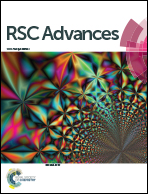Effects of different extrusion temperatures on extrusion behavior, phenolic acids, antioxidant activity, anthocyanins and phytosterols of black rice†
Abstract
Different extrusion temperatures (90, 100, 110, and 120 °C) were used to investigate changes in the expansion ratios, die pressures, phytochemical contents and antioxidant activities of extrusion products of black rice. The results showed that the die pressure significantly decreased with the increasing extrusion temperature, and the expansion ratio reached a peak value at 100 °C. The soluble-free and total phenolic acid contents gradually increased, whereas portions of soluble-free and soluble-conjugated phenolic acids transformed into insoluble-bound phenolic acids. The soluble-free (52.45) and insoluble-bound (73.59 mg GAE/100 g DF) total phenolic contents (TPC) reached peak values at 110 °C. The soluble-conjugated TPC values remained similar. Antioxidant activity occurred at higher levels in the range from 100 °C to 120 °C. The anthocyanin content decreased after extrusion possibly because some anthocyanin remained in the residue after extraction and could not be completely extracted. The content of free sterols increased from 90 °C to 110 °C and decreased at 120 °C. However, the content of bound sterols showed an opposite trend and reached a minimum value at 110 °C.



 Please wait while we load your content...
Please wait while we load your content...